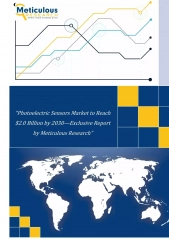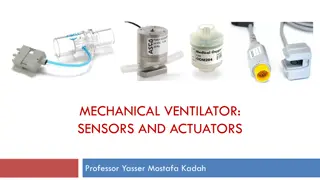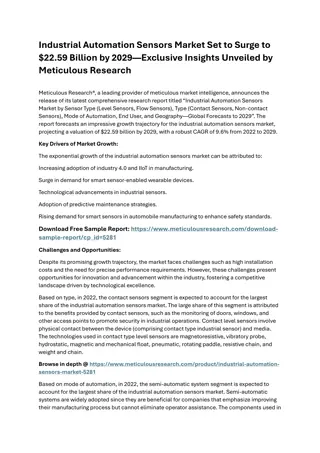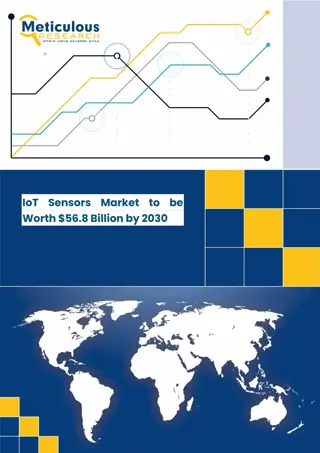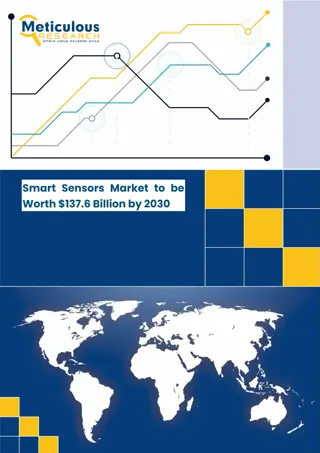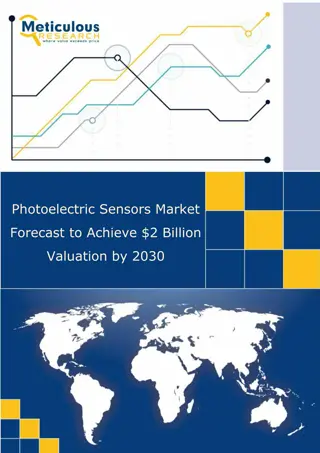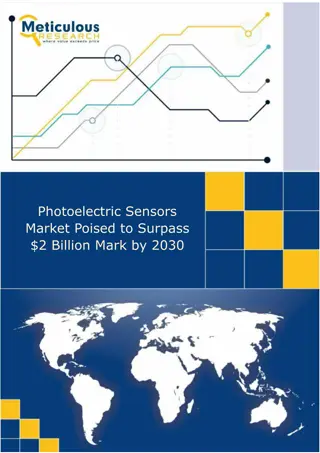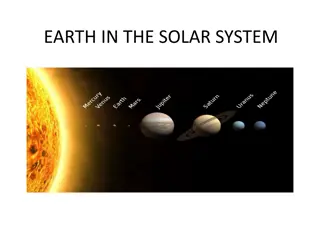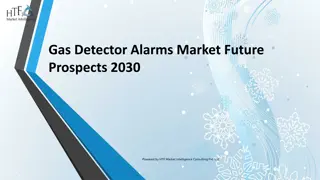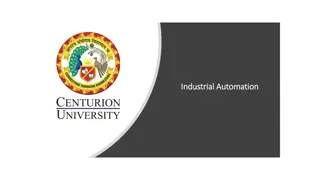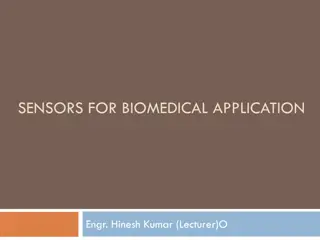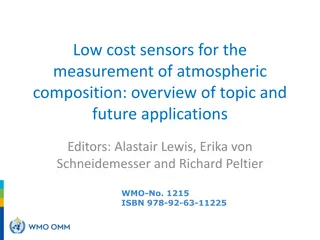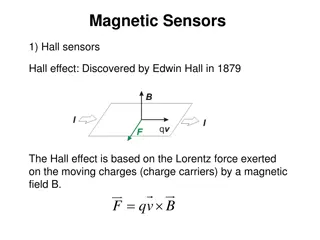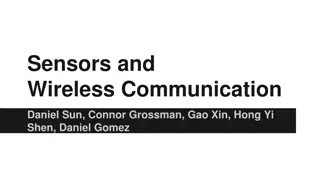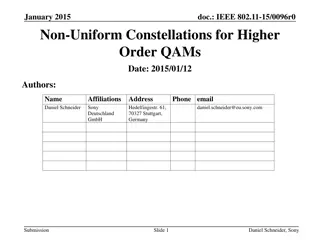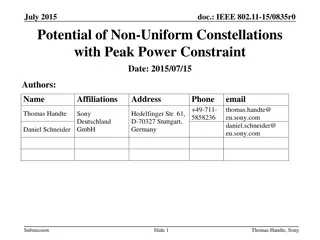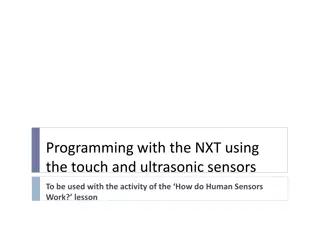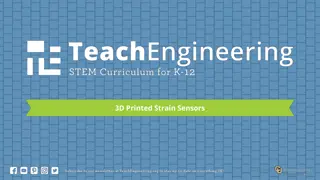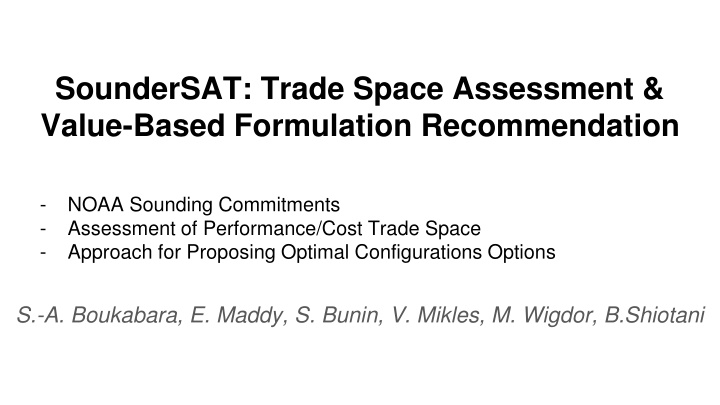
SounderSAT Trade Space Assessment and NOAA Sounding Commitments
Explore the trade space assessment and value-based formulation for SounderSAT, focusing on NOAA's commitments to WMO and the CGMS baseline. Learn about the different subcomponents and observing system performance.
Download Presentation

Please find below an Image/Link to download the presentation.
The content on the website is provided AS IS for your information and personal use only. It may not be sold, licensed, or shared on other websites without obtaining consent from the author. If you encounter any issues during the download, it is possible that the publisher has removed the file from their server.
You are allowed to download the files provided on this website for personal or commercial use, subject to the condition that they are used lawfully. All files are the property of their respective owners.
The content on the website is provided AS IS for your information and personal use only. It may not be sold, licensed, or shared on other websites without obtaining consent from the author.
E N D
Presentation Transcript
SounderSAT: Trade Space Assessment & Value-Based Formulation Recommendation - - - NOAA Sounding Commitments Assessment of Performance/Cost Trade Space Approach for Proposing Optimal Configurations Options S.-A. Boukabara, E. Maddy, S. Bunin, V. Mikles, M. Wigdor, B.Shiotani
What are Our Sounding Commitments? (to WMO) - WMO WIGOS 2040 vision - Subcomponent 1: Backbone system with specified orbital configuration and measurement approaches - This subcomponent shall provide the basis for Members commitments and should respond to their vital data needs; These are documented in the CGMS baseline (see next slide) - Subcomponent 2: Backbone system with open orbit configuration and flexibility to optimize implementation - This subcomponent shall be the basis for the open contributions of WMO Members and shall respond to target data goals. - Subcomponent 3: Operational pathfinders and technology and science demonstrators - This subcomponent shall respond to research and development needs. - Subcomponent 4: Additional capabilities - This subcomponent shall include additional contributions by WMO Members, as well as from the academic and private sectors. - The division of the observing capabilities into four subcomponents does not imply sequential priorities, that is, it is not expected that all Subcomponent 1 systems will necessarily be realized before elements of other subcomponents are addressed. The main distinction between the various subcomponents is the current level of consensus about the optimal measurement approach, especially the demonstrated maturity of that approach: there is stronger consensus for the capabilities included in Subcomponent 1 compared to those in Subcomponent 2, and so forth. It is likely that the boundaries between the groups will shift over time, for instance, some capabilities currently listed in Subcomponent 2 could transfer to Subcomponent 1.
What are Our Sounding Commitments? CGMS (LEO) - "....LEO may be sun-synchronous or drifting. Sun-synchronous orbits may have Equatorial Crossing Time (ECT) in the early morning (typically, 5:30 and 17:30), the mid-morning (typically, 9:30 and 21:30) or the afternoon (typically, 13:30 and 1:30). They overfly approximatively the same location of the Earth, including high latitudes, at approximatively the same time twice/day. For large-swath instruments, coverage at 4-hour intervals require three satellite at fairly-spaced ECT s. Drifting orbit provide more frequent coverage with decreasing latitude (missing high latitudes) and ensure the viewing of the Earth at changing times of the diurnal cycle. " Sensor Observation/Measurement Attributes Microwave Sounder - Atmospheric temperature, humidity, and precipitation - 3 sun-synchronous orbits, nominally early morning, mid-morning and afternoon Infrared Sounder - Atmospheric temperature, and humidity - Hyperspectral on 3 sun-synchronous orbits, nominally early AM, mid-AM and PM
What is an Observing System Performance? (Main Point: a Sensor accuracy is a subset of the Obs. System Performance) - - Performance is NOT just Accuracy of sensor measurement Performance Attributes: - Information Capability : Depends on sensors characteristics - Spatial coverage : Depend on sensor and constellation characteristics - Temporal coverage : Depends on constellation characteristics - Accuracy - Vertical Resolution : Depends on sensors characteristics - Spatial resolution - Measurement Density : Depends on sensor and constellation characteristics - Vertical validity range : Depends on sensors characteristics - Etc. Applications put different priorities (and requirements) on the performance attributes For example: Global NWP values a lot the capability, accuracy (noise level of radiance), the spatial coverage, temporal coverage, etc Precipitation monitoring, because of strong signal in MW, values spatial and temporal coverage above all (given the POD and FAR metrics used in this application skill assessment) : Dependent on Sensor characteristics : Depends on both sensors and constellation characteristics - - - - For the design & evolution of the space architecture, it is preferable to think about the Observing Systems (sensors in constellation configuration) performance, rather than single sensor accuracy.
What we learn from BAA (high level) from a science, technology/Cost perspective - MW case (what do we need to use ASPEN) - Major driving forces (for techn. And cost): Frequencies choice, refresh rate, accuracy. Others: swath, resolution, coloc w IR Move to high frequencies to fit smallsats Removing 23, 31 significantly helps cost. But possibility to add high-freq mitigation Easier to achieve lower noise levels for new technology MW sensors Different levels of performances possible in terms of capability, accuracy, etc TEMPEST-type (with only WV) is lower end of that spectrum ASMIS-type is higher end of that spectrum (while still smallsats) Cost of TEMPEST-type is Z % of ATMS (based on industry, IDL runs?, both?) -Lower end- Cost of ASMIS-type is Y % of ATMS cost (based on industry, IDL runs?, both?) -Higher end- Beyond ASMIS: Digital back end: could include higher-freq sampling with increase perfs (HyMS type) We should think of Obs. System : combination of sensors and constellations configurations Science IDL run: Performances of different obs systems were verified independently by SAT to assess if they correspond to, are less than or exceed ATMS T, Q, perfs (Accuracies Xs of these different options will be documented in ASPEN files) These performances will include accuracy, but also refresh rate (major drivers) Different combinations of constellations/satellites lead to different Ws refresh rates Cost of duplicating sensor is estimated to be V fraction of first sensor cost. Level after that. Not from BAA: Cost of data exploitation is similar to ATMS and is U and cost of exploiting addition sensor requires a fraction T% of the cost of exploiting first sensor Spatial resolution could be accounted for. Data points: ATMS and IDL run -based ATMS Disaggregation of MW and IR sensors could lead to reduced costs. It would add to temporal/spatial coverage - - - - - - - - - - - - - - - - -
Summary of Assumptions and Items to Estimate - On Cost factors: - T: Fraction % of extra cost of exploiting data beyond first sensor. To exploit successive sensors. Estimated to be 10%? - U: Actual cost of exploiting first sensor (it is assumed to be identical to ATMS). Assumed to be $20M? - Cost of current ATMS: $390M $100M - V: Cost of duplicating sensor is estimated to 90% (70%) of original sensor cost? - Y: Cost of ATMS-enhanced -type of sensor (in smallsat/cubesat). As a % of ATMS cost (assumed to be 30% 60% of ATMS for ASMIS type, 150% for DATMS type) - Z: Cost of ATMS-degraded -type of sensor (in smallsat/cubesat). As a % of ATMS cost (assumed to be 20% 10% for TEMPEST 12U type -w T, Q, or 5% for TEMPEST-D (only WV channels) - On Performance: - W: Refresh rates for different (swath/number of satellites): TBD (from BAA). Right now, we assessed refresh rates of 12 h (1 satellite), 6h (2 sats), 2h (6 sats) and 1h (12 sats) - X: Performances of different options (of sensors): accuracy, etc (Science IDL results). To be in SCP format. Should be bracketed by BAA studies: Currenely ATMS-degraded accuracy assumed to be 15%. ATMS-enhanced accuracy assumed 15% - Requirements & Weights (Global NWP) Observable Weights Observable Accuracy weight Observable Refresh rate weight Accuracy Requirement Range Refresh Requirement Range Temperature (K) 1 1 0.5 [2.5,2,1.5] [4h, 2h, 1h] Moisture (%) 0.5 1 0.5 [24,16,8] [4h, 2h, 1h] Goal is obtain: - 1: Comparative Assessment of observing systems benefits and values (benefit/cost ratios) based on the above.Of ATMS-enhanced-type and degraded-type sensors (and in between options) accounting for all what we learned. Assessing the trade space from BAA - 2: This in theory should lead to science-based recommendations of solution(s). Proposing sensors/constellations options -
Sensors MW Accuracy Overall Assessment (Moving to High Freqs and Lower Noise) Temperature performance wrt ATMS Moisture performance wrt ATMS TRL Added Benefits Approximate Cost comparison wrt A A: ATMS Baseline channels, ATMS noise levels TPW, RR, SWE, SIC, Cloud, etc Cost-A B: A with Improved Noise (0.25K for 50GHz, 0.35K for the 183GHz) Cost-B = fraction of Cost-A Improvement relative to baselines is mostly due to improved noise C: A plus 118GHz and 204 w Improved Noise (0.25K for 50GHz, 0.35K for the 183GHz 0.3K for 118GHz) Cost-C = fraction of Cost-A D: A plus 118 and 204 but w Real Noise levels from ATMS, MicroMAS-2 Cost-D = fraction of Cost-A F similar to E, a little worse in middle troposphere, but better in stratosphere Cost-E = fraction of Cost-A Small bump/degradation in middle/lower troposphere without low freq. E: A minus 23, 31 but plus 118 and 204, w Improved Noise (0.25K for 50GHz, 0.35K for 183GHz 0.3K for 118GHz) F: A but 50GHz replaced by 118 and w 204GHz and Improved Noise ( 0.35K for the 183GHz 0.3K for 118GHz) Cost-F = fraction of Cost-A Slight degradation in the stratosphere G: TEMPEST-D (only WV channels) Cost-G = fraction of Cost-A Significantly higher (>15%) Higher (5-15%) Equivalent (within 5%) Lower (5-15%) Significantly Lower (>15%)
Takeaways from the Sensors Assessment (Microwave Case) - Improving Noise (from ATMS levels to enhanced levels of : 0.25K for 50GHz, 0.35K for the 183GHz) has a positive impact across Temperature and Moisture accuracies Adding 118GHz and 204GHz to ATMS channels, but keping the same noise levels, does not necessarily add much value But Adding 118GHz and 204 GHz channels (to ATMS channels), but having the enhanced noise levels above, present an improved accuracy wrt ATMS Removing 23, 31 Ghz but adding 118GHz and 204GHz and using enhanced noise levels, leads to enhanced T accuracy but equivalent Q accuracy Replacing 50 Ghz with 118GHz channels and using enhanced noise levels, leads to ATMS-equivalent accuracies for T and Q TEMPEST having only moisture channels, has equivalent Q accuracy but not adequate T accuracy Bottom line: All the permutations tested (removing 23, 31, adding 118 Ghz, 204 Ghz, etc), but all using enhanced noise levels, all lead to equivalent or better accuracy than ATMS There is no lower (than ATMS)-performing sensors in these permutations - - - - - - -
Sensors/Constellation Assessment of Performance (Time/Space Coverage component of the performance only. LEO polar orbit assumption)* Color coding wrt CGMS Backbone Spatio-Temporal Coverage-4hrs assuming. Equal spacing assumed. Estimate W 1 Satellite 2 Satellites 6 satellites 12 satellites Average global refresh rate: 14 hours Average global refresh rate: 4.7 hours Average global refresh rate: 2.3 hours A: Swath of 1200 Kms -TEMPEST-D type Average global refresh rate: 15 hours Average global refresh rate: 7.5 hrs Average global refresh rate: 2.5 hours Average global refresh rate: 1.25 hours B: Swath of 2200 Kms - ATMS type Average global refresh rate: 12 hours Average global refresh rate: 6 hours Average global refresh rate: 2 hours Average global refresh rate: 1 hour C: Swath of 2800 Kms (ATMS-enhanced-type) Average global refresh rate: 11 hours Average global refresh rate: 5.5 hrs Average global refresh rate: 1.8 hours Average global refresh rate: 0.9 hours D: Swath of 3000 Kms Significantly higher (>15%) Higher (5-15%) Equivalent (within 5%) Lower (5-15%) Significantly Lower (>15%)
ASPEN Approach for Performance & Value Assessment How to Account for Accuracy, Refresh, Costs at the same time in assessing Observing Systems ability to meet NOAA Requirements - Step 1: Define performance (SCP) in terms of accuracy, refresh, other attributes (resolution, etc) For Observing System 1: Accuracy Option A, Refresh Rate Option DA , (and options of Spatial resolution) For Observing System 2: . Etc - Step 2: Compute cost based on formula (assuming observing system is composed of N satellites, each with a number M of similar sets of sensors Sensor_j (j=1,M) on each of the satellite_i (i=1,N), - Step 3: Use ASPEN with SCP inputs and Cost estimates above. Assess using the Global NWP ref
Highlight of ASPEN-based Assessment -Trade Space (Benefit -Global NWP used as a reference)
Highlight of ASPEN-based Assessment -Trade Space (Value or Benefit/Cost ratio estimation)


